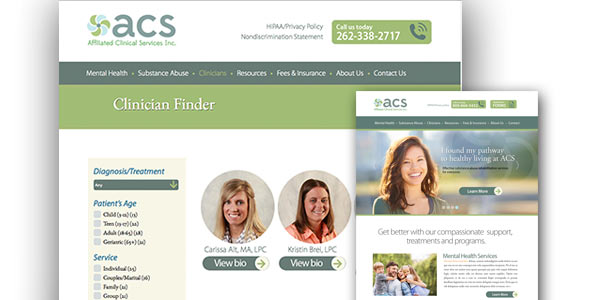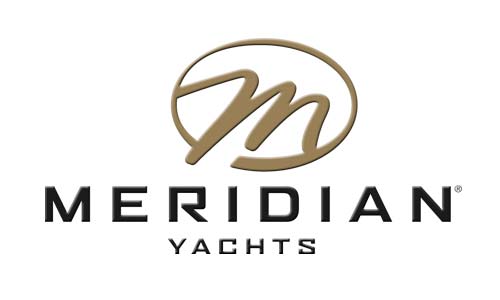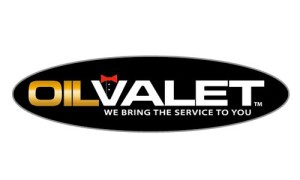June 14, 2017

We would like to introduce you to Affiliated Clinical Services (ACS)’s new website. After the completion of their new building, at an easily accessible location, Affiliated Clinical Services wanted to make their online resources easy and accessible as well. With the new building, also came a new logo, fresh color scheme and overall updated look and services approach. Affiliated wanted their website to reflect their new approach and appearance. We at Guild Creative could not agree more. When your logo, signage, colors, brochures, all have a similar look and feel and your messaging is consistent in all these resources as well, it significantly adds to your overall brand identity.
Our goal in revamping their website was to enhance their new brand identity and make the information on their new website easy to find and accessible to all who may need the help and resources ACS has to offer.
One key feature of the new ACS website we designed was their Diagnosis/Treatment form and Clinician Finder. ACS has a vast number of Clinicians to choose from. The Diagnosis/Treatment forms helps users narrow the search to quickly find the best-suited counselors. Easy access to each clinician’s bios helps patients learn more about the individual doctors or therapists as well.
Check out http://affiliatedclinical.com and let us know what you think about their new website. Contact Steve for ways to help update your website. steve@guildcreative.com
June 14, 2017

Don’t underestimate the power of color. Color plays a critical role in branding, helping to create a positive image, assisting in brand recall, conveying your message, and more. Color is a key component in your overall marketing message and plays one of the largest roles to help elicit strong feels, emotions and/or desired purchase behaviors.
The color you choose should help you stand out—set you apart from your competition. It should be relevant to your business, industry or product. It also should have a connection to your audience. These all factor into helping aid in your brand/image recall.
The true meaning of any color varies greatly, but this write up says it best. According to entrepreneur.com:
Blue: Like the sky and sea is serene, also perceived as trustworthy, dependable, fiscally responsible and secure.
Red: Red is an attention-getting color of passion, but it also makes the viewer think of a Stop sign or Warning. What response are you hoping to create? Red can be aggressive, energetic, and provocative; so while attention-grabbing, it may also evoke an unfavorable response.
Green: In general, green suggests health, freshness and growth. The gamut of green shading promotes from a deep, dark and lush green, the feeling of prestige to the lighter greens with a feeling of refreshing and calming.
Yellow: Yellow is most always associated with the sun. Suggesting optimism, positivism, light and warmth. The eye sees bright yellows before any other color, making them great for point-of-purchase displays.
Purple: Purple is a color of emotions. Purple being a blend of reds and blues, passion and tranquility, is often associated with royalty and/or spirituality, along with mystery and sophistication.
Orange: Cheerful orange evokes exuberance, fun and vitality. Research indicates its lighter shades appeal to an upscale market. Peach tones work well with health care, restaurants and beauty salons.
Black: Black is serious, bold, powerful and classic. It creates drama and connotes sophistication. Black works well for expensive products, but can also make a product look too bold and heavy.
The color palette you can choose from is nearly endless. We have just provided you here with a quick snap shot of the main primary colors to consider in both your logo and branding, but there are so many more to consider.
What message is your color sending to your buyers? Keep your colors and messages true. Talk with Steve our design and color expert. steve@guildcreative.com
August 10, 2016

If you think your website does not need to be “responsive” to fit on mobile devices, we suggest you ought to rethink that thought. Better yet, read this article right now. In today’s business age, your site absolutely must be mobile ready. And here is why . . .
If you think that you don’t need your website to be mobile friendly because you simply do not have mobile users visiting your site, then think about this statistic: According to Smart Insights, “mobile digital media time in the U.S. is now significantly higher at 51 percent compared to desktop (42 percent)”.
So if your customers are searching for you, your product or service on a mobile device and they can’t find you, you have just lost out to your competitors whose mobile/responsive site can be found.
Still don’t think your customers are searching for you mobilely? Well statistics show that more than half of your customers are already there.
Another important factor to consider is that if your site is not mobile ready, Google will not register your site in their search results. You will loose critical ranking with Google. In addition, companies that have optimized their site for mobile users will be rewarded by having their ranking improved. Either way, without a mobile-ready site, you lose.
At Guild Creative, we recently launched two updated websites we helped make mobile ready.
http://weirfinancial.com
Weir Financial wanted their site to be mobile friendly making it easier to help inform and educate viewers on important investment and planning information. They have now put a number of financial resources and information into the hands of their new mobile users.
http://www.cretexseals.com
The goal behind updating the Cretex Specialty Products website was to provide their customers in the field with tools to better research their products and services. Many on-site contractors are using mobile devices to bring the office with them wherever they are. Cretex wanted to provide access to the products and specs that would be helpful while on the job. We enhanced the website with larger product images, quick key functions to open spec sheets, and an interactive graphic for product resources.
Two terrific companies to work with and we enjoyed creating a responsive website solution to meet both their own and customer needs.
Responsive sites are where it’s at—and where your site should be at as well! Call Guild to get your site responsive and mobile ready–262-677-4696
June 9, 2016

SEO & SEM
SEO (Search Engine Optimization) was once the primary focus for increasing your website visibility. Now there is a new focus called Search Engine Marketing (SEM). According to Google, it is important to use both to help increase the awareness and visibility of your site.
When you search and hit enter, those search results do not show up on the first page by accident. There’s a good chance that there is someone behind the scenes (web designer, SEO specialist, marketer or small business owner) making sure their website shows up in the search rankings when their product or services match what the user is looking for.
However SEO alone is just not enough any longer. Now to increase the chances that your website will appear in the top query, you will want to be sure to add SEM into your website marketing mix.
So, are you one to ignore the ads at the top of your online searches or are you one to take the quick way out and see what those ads have to offer? More and more, viewers are choosing to click on the ads and the SEM results are increasing for those using Google Adwords or the Pay Per Click (PPC) advertising. Finding the right balance for your particular business is what is most important. Let Guild Creative help you develop your best SEO and SEM strategy and increase your website rankings.
June 9, 2016


What does your logo say about you? What should it be saying? Is your logo something people will remember? Think of the logos for the following brands: McDonald’s, Nike and Apple. We all know the golden arches, the Nike swoosh and the silver apple with the one missing bite. These brands all have a memorable logo. We don’t need to even see the name of the brand to know who they are.
Your logo is the face of your brand. It identifies who you are and the one element that will symbolize your brand more than anything else. It is what will help keep your name/your product/your company in front of your customers. You will put your logo on signs, business cards, letterhead, invoices—everywhere you can think to be sure you are seen and remembered. So it is so important to get the design of your logo right the first time. To create and select the perfect logo design, you will want to think about the following:
• Who is your target audience?
• Who are you competing with?
• How are you different from your competitors?
• What kind of feelings do you want your logo to encourage?
• What kind of qualities do you want your logo to display?
• Would you like a tagline included in your design?
• Do you like the idea of a symbolic logo, a typographical logo or a mixture of the two?
Key components of a good logo:
• Does it properly represent my business?
• Is it distinctive, simple and clean?
• Is it functional across all mediums?
• Does it speak my message?
Many online services offer to create a logo for you for a mere $99. But remember, “you get what you pay for” and it is worth investing in a high quality, customized logo to identify who you are and provide memorable features specific for your brand, your company. Contact Guild Creative to help create a distinctive design just for you.
June 9, 2016
Our lives are so inundated with information and too many messages, we have learned to ignore the messages being thrown at us daily. Consumers having grown up in today’s information age, know that information is the key. We seek out the information that we are most interested in. The key here is that today’s consumers are “seeking out” information. So as a marketer it makes sense that you should be providing that key information consumers are seeking. Enter Content Marketing!
Today’s marketers are providing content to consumers with the purpose to attract and retain customers by offering information that is relevant and informative to positively encourage consumer behavior to make that purchase.
Rather than advertising that bombards us with messages to buy this or that, content marketing engages the consumer in conversation and encourages them to learn more without directly selling anything. You are selling the value proposition of your product by providing relevant information. If well written, you help the consumer make an informed decision to buy the product you are offering.
Good content marketing grabs attention by informing the consumer first and encourages them to behave (purchase) accordingly. Content is key and at Guild Creative, we help provide the content you need.
May 26, 2015
So, you’re ready to have a website created for your small business? That’s great! A professionally designed website can greatly increase the exposure of your product or service, provide potential customers with the information they are looking for to make an educated decision and become a beneficial sales tool that you can continually monitor and improve. A website is truly an investment that has the potential to grow your business exponentially.
But before we can put our heads together to create a design that beautifully showcases your brand, you will need to answer a few questions:
- Why do you want to create a website for your small business?
- What are you hoping the website will accomplish?
- What are your marketing goals?
Once you have your general website goals established, we will want to dive into more marketing-related questions:
- How do you define your products and services?
- What makes your product or service different from your competitors?
- Who is your target audience?
All of these questions help us learn more about you and your business which then helps us create a website that properly displays your company and achieves the goals you are looking for.
The most common question that is asked of us before the design process is, “How much is it going to cost?” Unfortunately, the answer is one that nobody likes to hear, “It depends.”
Every project is different. Some websites need four simple pages, other websites are more complex and require lots of time to code while others need a full branding strategy in additional to a company website. That being said, it is impossible to give a quote without first learning all of your online needs.
Making the decision to have a website created for your small business is an exciting one, but requires a little homework before the design process can begin. Once you have clearly defined your marketing goals and objectives, the website design process can kickoff.
May 26, 2015
You may have heard the term, ‘search engine optimization,’ but do you know what it means?
We’ll start to answer this question with an example. When you are looking for a new business, your search likely starts online. You go to your favorite search engine and type in exactly what you are looking for. When you hit “Enter,” you are given a list of results that match your query.
Those results did not show up on the first page by accident. There’s a good chance that there is someone behind the scenes (web designer, SEO specialist, marketer or small business owner) making sure their website shows up in the search rankings when their product or services matches what the user is looking for.
Now here’s the official definition from the search engine giant, Google:
Search engine optimization (n.): the process of maximizing the number of visitors to a particular site by ensuring that the site appears high on the list of results returned by a search engine.
Why would someone want their site to show up on the first page or be #1 of the search results? Simply because your website has the best chance of being clicked on by a potential customer when your company is in the #1 slot.
SEO involves two halves: on-page optimization and off-page optimization.
On-page optimization is the part of the strategy that you can control with elements found on your website. This process involves a mix of both art and science. The foundation of on-page SEO is keyword research or finding what search terms customers use to find your area of business. There are tools available online which track certain key terms.
Once you have found the right keywords, your next step is use them in applicable areas of your website including title tags, meta descriptions, image descriptions, headlines and copy. The key is to keep it natural. You are not trying to trick anyone (including the search engines ) you are trying to help those who are looking for the product and service that you offer.
The other half of SEO is called off-page optimization. Search engine algorithms, a significant influence on your page rankings includes the number of websites that point back to your website. These websites could be directories, blogs, social media sites or more. Each site that directs to your site acts as a vote. They say to the search engines, “This is a quality authoritative website.”
This doesn’t sound difficult, but it certainly can be. The biggest challenge is managing the sites that point back to yours. It’s not about quantity, it’s about quality. Unfortunately, there are a lot of non-quality, spammy websites on the internet. If a low-quality website points back to your site, it can count as a vote against you.
The process of off-page optimization involves creating a strategy that promotes good votes back to your website and limits the number of counts against your website.
Search engine optimization can be a tough strategy to master if you are new to the industry and don’t have a lot of time to learn the skill. However, when you hire an experienced professional to build a strategy for your small business, you can trust that the traffic back to your website will keep on coming.
To learn more about SEO and find out if it the expense is worth the investment, watch for the next blog post, “What is SEO and can it help your small business? (Part Two).”
March 8, 2014
Let’s play a game of Memory. Could you describe the logo of the following brands: McDonald’s, Nike and Apple? Of course you could. We all know the golden arches, the Nike swoosh and the silver apple with the one missing bite. These brands all have a memorable logo. We don’t need to see the name of the brand to know who they are.

A logo is the face of your brand. It is the one element that will symbolize your brand more than anything else. You’ll put it on your signs, business cards, letterhead and invoices. You’ll put your logo everywhere so it’s important to get it right the first time. In order to create and select the perfect logo design, you’ll want to follow these steps:
1. Select a budget
Prices can range anywhere from $300 to hundreds of thousands of dollars. There are many factors in determining the price including the project requirements, the size of your business, the media where it will be used and the experience of the designer.
2. Find a designer and request a quote
See “Small Business Tips for Choosing a Resource to Create Your Corporate Identity”
There are hundreds of designers in the state of Wisconsin. Make this process a little easier on yourself by asking other small business owners or searching for reviews and testimonials online. Once you have selected a few, contact them and engage them in a discussion and general discovery session, so the designer can learn more about your business and get a better feel for the project scope and your company’s persona. If you have an idea in mind let them know and also let them know if you’re looking for a complex illustrative solution (they take more time). Ask them for a quote for three initial designs and for three rounds of refinement for design of choice.
3. Select your designer
After talking with the designers, choose the designer that best fits your needs; this involves more than just price.
• They should have a proven track record for producing good logo designs.
• They should have a good understanding of how businesses operate and ideally ones that are
typical in your market.
• They should be willing to take the time to learn about your company and its products and
services, and check out your competition’s brand.
• They should be a good fit for the size of your company and budget.
• They should show a genuine interest in your company by asking questions and making
suggestions.
• They should have a clear understanding of the basic of sales and marketing, and what branding
is all about.
Another factor that may get overlooked, but is so important, is compatibility. Did you feel the designer listened to your needs and was easy to work with?
4. Talk with your designer about your project
Before meeting with your designer, you’ll want to ask yourself the following questions:
• What don’t you like about your current logo? (If you have one.)
• What kind of feelings do you want your logo to encourage?
• What kind of qualities do you want your logo to display?
• Would you like a tagline included in your design?
• Do you like the idea of a symbolic logo, a typographical logo or a mixture of the two?
Your designer will then likely ask questions to learn more about you and your small business such as:
• Who is your target audience?
• Who are you competing with?
• How are you different from your competitors?
5. Select a logo concept
After a given amount of time, your designer will come back to you with a couple of different design mock-ups. Pay special attention to the one that catches your attention. Ask yourself:
• Does it properly represent my business?
• Is it distinctive, simple and clean?
• Is it functional for all my mediums?
• Does it speak my message?
Be sure not to rush this selection process, take some to consider all of the choices.
6. Give good feedback
Each designer knows that he or she will not get the concept exactly right the first time so don’t be afraid of hurting any feelings. Explain what you do or don’t like about the designs. Try and communicate your needs as effectively as possible. Be specific.
With good feedback, your designer should be able to create your ideal business logo.
Creating a logo for your business is not a simple task, but is so important for your company image. Your logo can showcase your small business qualities and communicate your message. When you create the perfect logo the first time, it will last as long as your business.













